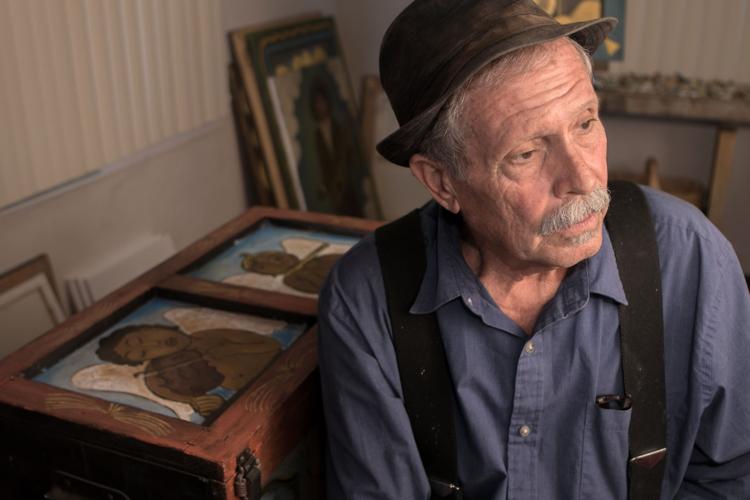Francisco Franklin has recurring images coursing through his mind: a woman palming tortillas over a steel drum, a musician with his instrument, cherubs, mountains. These are the faces, landscapes and imaginations he grew up seeing as a kid in Sonora, which he came to appreciate and make visceral connections with.
“I had the most extraordinarily beautiful childhood you could ever have,” said the 70-year-old Franklin.
For more than 50 years, Franklin has translated his cherished childhood images into his art — paintings, stone carvings, woodwork. Untrained in any art school but schooled by his will and creativity, Franklin’s artworks not only mirror his inner thoughts and recollections, but also our rich, colorful Southwestern border culture.
The woman with long black hair and a light-blue shawl over her shoulders making tortillas is the nana from Magdalena, Sonora, or from South Tucson. The mariachi is the same one heard at restaurants in Nogales, Sonora, or at Tucson street festivals. And the cherubs are the universal angels crossing the border — north and south, unimpeded.
“It’s all a reflection of my life in Sonora,” said Franklin, who was born in Tucson, then raised in his first 14 years on a ranch between Caborca and the coastal Seri village of El Desemboque. He was home-schooled and read biographies of artists.
Franklin, who eschews exhibiting his art in most galleries, has a small following of devoted fans who appreciate his rainbow palette, the human warmth in his art — whimsical, poignant and melancholy — and his passion.
His works are “very much about the Southwest,” said Heidi Baldwin, a Tucson Realtor who has known Franklin for 30 years and collects his art.
Adrienne Halpert, owner of Global Arts Gallery in Patagonia, one of the few galleries to carry Franklin’s art, cites his vision as one of his artistic strengths. She calls him a “treasure.”
“He has a song to sing and he’s been singing it,” said Halpert, who has carried his art for nearly 10 years. “When someone is committed to that vision, that person is an artist.”
Franklin’s Chicago-born parents came to Tucson shortly before the outbreak of global war. His father served in the military during World War II and after his discharge, couldn’t cope with life in Tucson. He moved the family to Sonora, where he ranched and where the young Francisco was nurtured.
“They accepted me,” he said of the Sonorenses. In the self-sufficient, respectful families in rural 1950s Sonora, he saw grace, dignity and “old regal manners.” He learned how industrious the people were because they could “make beautiful things with no tools.”
“I learned you can do a lot with very little,” said Franklin, who is bilingual, during a visit to his midtown home that doubles as his studio. He recently moved there after living for 30 years in Barrio Anita, where some of his art can be seen on exterior walls.
He was 15 when he “consciously” turned to painting because he wanted to create beautiful things. But in the course of learning and teaching himself, he endured a period of personal struggles, alcoholism, and life in the military after being drafted in the early 1960s.
He traveled and lived in Europe — Sweden, France, Germany and Iceland — adding balance and perspective during the years he pursued his ambition.
“I called myself an artist before I was,” said Franklin, in a low, soothing voice. When he made another deliberate decision — to give up drinking — he immersed himself in his art, which has been a rewarding but solitary life.
His small house is filled with his works, including tables he crafted and carvings made from limestone that he gets in east-central Texas. Outside he has a small work space where he does his woodworking, including making all the frames for his paintings.
In the backroom of the house, several paintings stand upright in the corner. Brushes and paints cover a table, and a cherub-adorned box, a work in progress, sits in the middle. Next to the box, on an easel, is a painting of Our Lady of the Immaculate Conception. The son of atheists, Franklin paints religious figures in honor of the strong faith that the Sonorans exhibited in the face of adversity.
Among his favorite subjects are mariachis “for their vigorous passion for life,” he said. But his most common images are of women — the familiar archetype goddess, mother and Madonna, said Halpert.
Franklin says he recognizes the limitations of his artistic talents, but that he supplants what he lacks with emotion. He says painting is like “finding his way through the dark.” From that dark room burst bright colors and vivid images.
He works at his art with focus. It’s his life. He creates what he sees in his bank of memories and in the life around him. And he strives to create beauty as he knows it — and remembers it.









